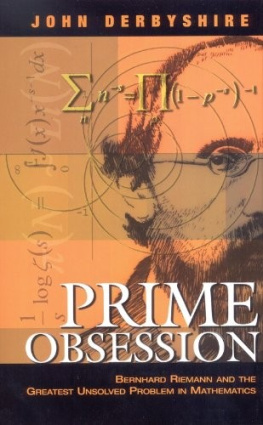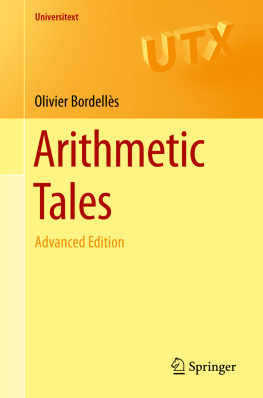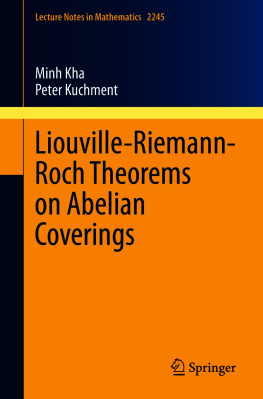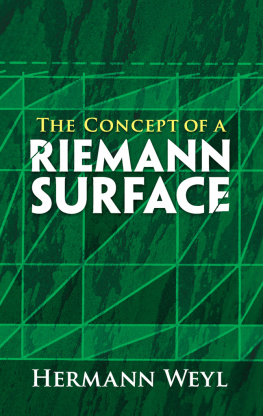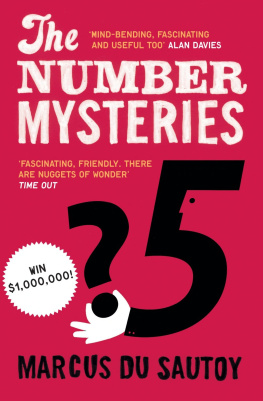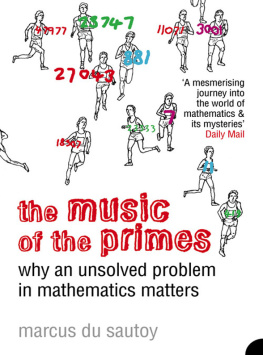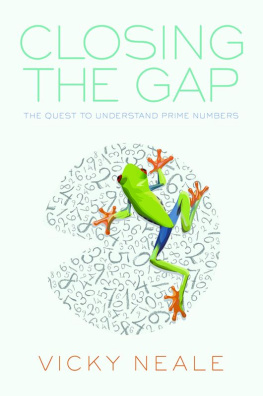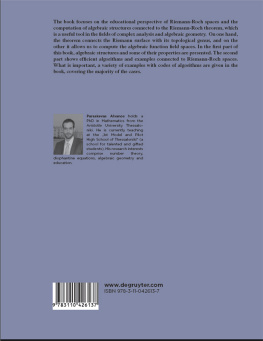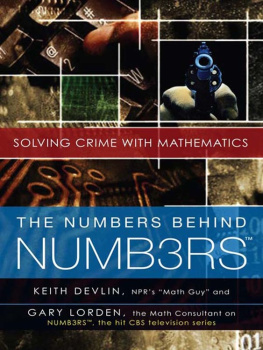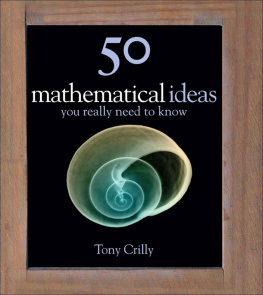John Derbyshire - Prime Obsession: Bernhard Riemann and the Greatest Unsolved Problem in Mathematics
Here you can read online John Derbyshire - Prime Obsession: Bernhard Riemann and the Greatest Unsolved Problem in Mathematics full text of the book (entire story) in english for free. Download pdf and epub, get meaning, cover and reviews about this ebook. year: 2003, publisher: Joseph Henry Press, genre: Children. Description of the work, (preface) as well as reviews are available. Best literature library LitArk.com created for fans of good reading and offers a wide selection of genres:
Romance novel
Science fiction
Adventure
Detective
Science
History
Home and family
Prose
Art
Politics
Computer
Non-fiction
Religion
Business
Children
Humor
Choose a favorite category and find really read worthwhile books. Enjoy immersion in the world of imagination, feel the emotions of the characters or learn something new for yourself, make an fascinating discovery.
- Book:Prime Obsession: Bernhard Riemann and the Greatest Unsolved Problem in Mathematics
- Author:
- Publisher:Joseph Henry Press
- Genre:
- Year:2003
- Rating:4 / 5
- Favourites:Add to favourites
- Your mark:
Prime Obsession: Bernhard Riemann and the Greatest Unsolved Problem in Mathematics: summary, description and annotation
We offer to read an annotation, description, summary or preface (depends on what the author of the book "Prime Obsession: Bernhard Riemann and the Greatest Unsolved Problem in Mathematics" wrote himself). If you haven't found the necessary information about the book — write in the comments, we will try to find it.
In August 1859 Bernhard Riemann, a little-known 32-year old mathematician, presented a paper to the Berlin Academy titled: On the Number of Prime Numbers Less Than a Given Quantity. In the middle of that paper, Riemann made an incidental remark a guess, a hypothesis. What he tossed out to the assembled mathematicians that day has proven to be almost cruelly compelling to countless scholars in the ensuing years. Today, after 150 years of careful research and exhaustive study, the question remains. Is the hypothesis true or false?
Riemanns basic inquiry, the primary topic of his paper, concerned a straightforward but nevertheless important matter of arithmetic defining a precise formula to track and identify the occurrence of prime numbers. But it is that incidental remark the Riemann Hypothesis that is the truly astonishing legacy of his 1859 paper. Because Riemann was able to see beyond the pattern of the primes to discern traces of something mysterious and mathematically elegant shrouded in the shadows subtle variations in the distribution of those prime numbers. Brilliant for its clarity, astounding for its potential consequences, the Hypothesis took on enormous importance in mathematics. Indeed, the successful solution to this puzzle would herald a revolution in prime number theory. Proving or disproving it became the greatest challenge of the age.
It has become clear that the Riemann Hypothesis, whose resolution seems to hang tantalizingly just beyond our grasp, holds the key to a variety of scientific and mathematical investigations. The making and breaking of modern codes, which depend on the properties of the prime numbers, have roots in the Hypothesis. In a series of extraordinary developments during the 1970s, it emerged that even the physics of the atomic nucleus is connected in ways not yet fully understood to this strange conundrum. Hunting down the solution to the Riemann Hypothesis has become an obsession for many the veritable great white whale of mathematical research. Yet despite determined efforts by generations of mathematicians, the Riemann Hypothesis defies resolution.
Alternating passages of extraordinarily lucid mathematical exposition with chapters of elegantly composed biography and history, Prime Obsession is a fascinating and fluent account of an epic mathematical mystery that continues to challenge and excite the world. Posited a century and a half ago, the Riemann Hypothesis is an intellectual feast for the cognoscenti and the curious alike. Not just a story of numbers and calculations, Prime Obsession is the engrossing tale of a relentless hunt for an elusive proof and those who have been consumed by it.
**
Amazon.com ReviewBernhard Riemann was an underdog of sorts, a malnourished son of a parson who grew up to be the author of one of mathematics greatest problems. In Prime Obsession, John Derbyshire deals brilliantly with both Riemanns life and that problem: proof of the conjecture, All non-trivial zeros of the zeta function have real part one-half. Though the statement itself passes as nonsense to anyone but a mathematician, Derbyshire walks readers through the decades of reasoning that led to the Riemann Hypothesis in such a way as to clear it up perfectly. Riemann himself never proved the statement, and it remains unsolved to this day. Prime Obsession offers alternating chapters of step-by-step math and a history of 19th-century European intellectual life, letting readers take a breather between chunks of well-written information. Derbyshires style is accessible but not dumbed-down, thorough but not heavy-handed. This is among the best popular treatments of an obscure mathematical idea, inviting readers to explore the theory without insisting on page after page of formulae.
In 2000, the Clay Mathematics Institute offered a one-million-dollar prize to anyone who could prove the Riemann Hypothesis, but luminaries like David Hilbert, G.H. Hardy, Alan Turing, Andr Weil, and Freeman Dyson have all tried before. Will the Riemann Hypothesis ever be proved? One day we shall know, writes Derbyshire, and he makes the effort seem very worthwhile. --Therese Littleton
From BooklistBernhard Riemann would make any list of the greatest mathematicians ever. In 1859, he proposed a formula to count prime numbers that has defied all attempts to prove it true. This new book tackles the Riemann hypothesis. Partly a biography of Riemann, Derbyshires work presents more technical details about the hypothesis and will probably attract math recreationists. It requires, however, only a college-prep level of knowledge because of its crystalline explanations. Derbyshire treats the hypothesis historically, tracking increments of progress with sketches of well-known people, such as David Hilbert and Alan Turing, who have been stymied by it. Carrying a million-dollar bounty, the hypothesis is the most famous unsolved problem in math today, and interest in it will be both sated and stoked by these able authors. Gilbert Taylor
Copyright American Library Association. All rights reserved
John Derbyshire: author's other books
Who wrote Prime Obsession: Bernhard Riemann and the Greatest Unsolved Problem in Mathematics? Find out the surname, the name of the author of the book and a list of all author's works by series.

